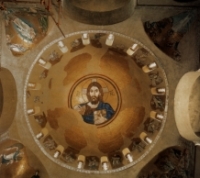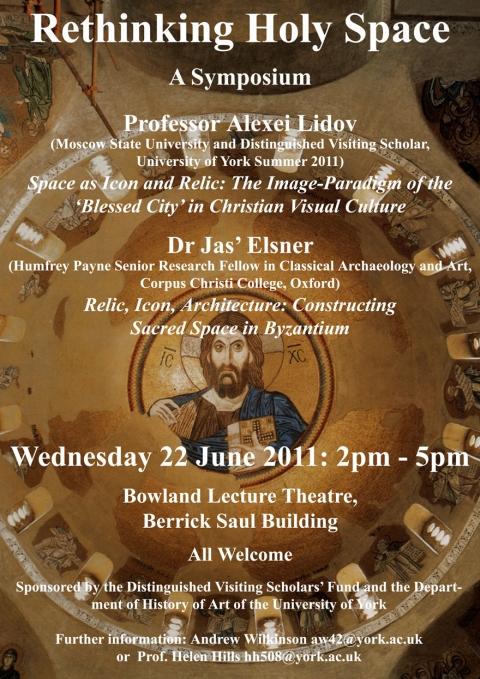Rethinking Holy Space Research Symposium
Wednesday 22 June 2011, 2.00PM to 17:00
Speaker(s): Professor Alexei Lidov, Dr Jas' Elsner and Helen Hills
Location: Bowland Auditorium, Berrick Saul Building
Summary
Professor Helen Hills will Chair a symposium on 'Rethinking Holy Space' as part of a series of events to be held during his visit to the UK May-June 2011. With papers by Professor Alexei Lidov (Moscow State University and Distinguished Visiting Scholar, University of York Summer 2011) Dr Jas' Elsner, University of Oxford.
All are welcome!
Other events include the Graduate Symposium exploring 'Holy Space and the Senses' and an open lecture on 'Hierotopy, Spatial Icons and Image-Paradigms.'
Programme
Rethinking Holy Space Research Symposium
with
Professor Alexei Lidov & Dr.Jas' Elsner
Programme:
2.00-2.10: Helen Hills (History of Art, University of York): Introduction
2.10-3.00: Alexei Lidov (Moscow State University and Distinguished Visiting Scholar, University of York Summer 2011): Space as Icon and Relic. The image-paradigm of the ‘blessed city’ in Christian visual culture
The paper deals with medieval perceptions of holy space as icon and relic, together with a new notion of the image-paradigm which advances the terms of this discussion beyond a positivist description of artefacts. The case of the Holy Gate in the ‘blessed city’ of Edessa is the focus of my discussion here. According to a tradition, it was the holy space where the two greatest relics of Christendom were displayed for centuries: the Holy Mandylion - the only image miraculously created by Christ himself, as a kind of self-portrait 'not made by human hands', and the Letter to Abgar of Edessa which was the only text written by Christ himself as a kind of a divine autograph. The stories of these two major relics were closely interwoven. Both were perceived as apotropeia and magic objects, which were sometimes conceived and treated as a single whole inseparable from the Holy Gate of Edessa – the space of their display. I will argue that this specific phenomenon profoundly influenced Byzantine church iconography as well as the practice of icon-worship. Furthermore, the combination of two relics, revealing a topos of the holy space of Edessa, emphasized the spatial aspects of Christian imagery and created an image- paradigm that endured for centuries.
3.00-3.50: Jas’ Elsner: (Humfrey Payne Senior Research Fellow in Classical Archaeology and Art, Corpus Christi College, Oxford) Relic, icon, architecture: constructing sacred space in Byzantium.
One aspect of the Christian, and especially the Byzantine, redefinition of the holy lies in its passage into a hidden space of mysterious (even mystic) secrecy whose existence was announced and access to which was enabled through material framing and visual representation. The origins of secrecy in relation to the holy go deep into pre-Christian antiquity, but central to the Christian articulation of these issues is the rise of the cult of relics and the relation of holy material to its packaging, presentation and framing.
Sponsored by the University of York Distinguished Visiting Scholars Fund and the Research School for Architectural History & Theory, Dept of History of Art.


